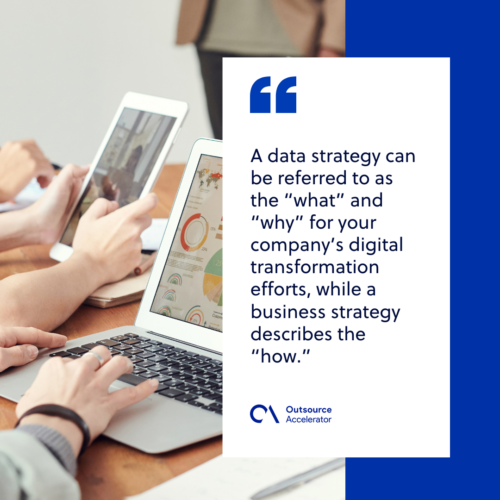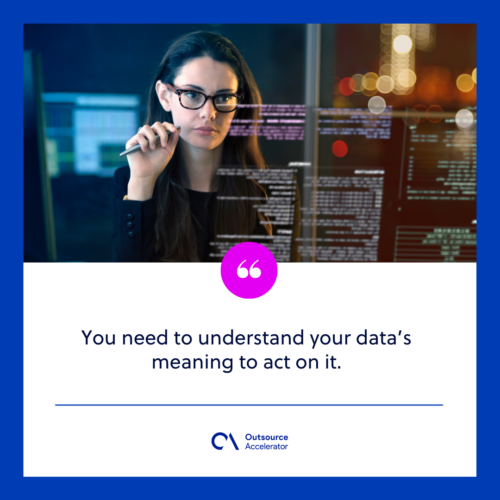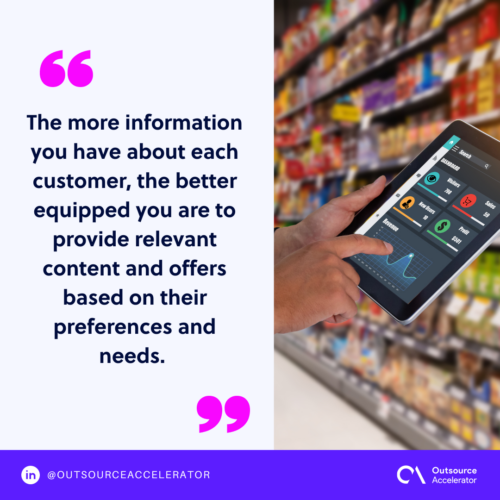12 key elements of an effective data strategy

Data has spread throughout the modern world. From the moment we wake up and check our smartphones to the numerous daily transactions, data is generated at an unprecedented scale.
Data is growing exponentially, and organizations are presented with the challenge of how to decide what to do with their own data. Zippia reports that 97.2% of companies claim they’re investing in big data, but only 24% describe their organizations as data-driven.
With so much data available, we can use it to drive innovation and improve decision-making. But to do this successfully, we must first understand what our business needs from our data and how we can best use it.
This is why you need a data strategy. In this article, we’ll explore the essential elements of a data strategy and their benefits to your business.
What is a data strategy?
A data strategy is a big-picture plan for how your company will use data to gain a competitive advantage. It describes how your company’s data efforts fit the broader organizational strategy.
A data strategy can be referred to as the “what” and “why” for your company’s digital transformation efforts, while a business strategy describes the “how.”
A data strategy also serves as a roadmap for how your organization collects, stores, and analyzes data. It will help you determine things like how much to spend on technology, how much time to invest in training, and how to bring new people in.

12 key elements of a data strategy
The elements of a data strategy encompass various components that are essential for organizations to leverage data and derive value from it effectively.
These elements provide a framework for developing a comprehensive data strategy tailored to the specific needs and goals of the organization.
Let’s explore the key elements of a data strategy:
1. Data culture and skills
Data is a strategic asset for your business, but getting the right people on board to manage it can be difficult. Your priority should be to build a data-driven culture that encourages collaboration across different departments.
A data strategy should also include a plan for how you will teach data and how to use it effectively. Create an environment within your company that supports learning about data.
2. Data strategy alignment with business goals
The data strategy should be aligned with business goals. It should be used as a tool to support strategic initiatives and not as an end in itself.
The value of a data strategy is directly tied to your organization’s strategic objective. So before developing one, ensure you understand the business goals driving it.
This will help you detect where to focus your efforts when it comes to:
- Deciding what data to collect
- How much information to store and analyze
- How often you should evaluate what processes are working
3. Data ethics
Data ethics examines the social, legal, and ethical issues surrounding data collection, use, and storage. It’s an emerging field of study that guides how we can ethically manage data in ways that respect human rights.
Your data strategy should not aim to simply comply with legal requirements. Data ethics requires us to think critically about the impact of data science, artificial intelligence, and machine learning on society at large.
Failure to include this element would lead to negative consequences like data bias and privacy breaches.
4. Data governance
Data governance is a set of policies and processes that ensure the right data is available at the right time, format, and context for analysis. It’s the process by which an organization ensures that its data strategy is being followed.
The framework for data governance helps companies to:
- Define their data roles and responsibilities
- Establish standards for quality and security
- Define the processes for cleaning and developing new data sets
- Create a process for data sharing and access
5. Data collection and acquisition
Data is often stored in various systems and databases, which makes it hard to get the full picture.
Data collection gathers data from those disparate sources and puts it in a single location. Data acquisition specifically places the data into your organization’s systems and databases.
6. Data storage and management
Data storage and management is the process of capturing and retrieving data. It’s important to store data in a way that allows it to be accessed quickly and efficiently.
A data strategy may have offline and online modes of data storage:
- Offline data storage means that the data is stored on physical media such as tapes, disks, or solid-state drives (SSDs).
- Online data storage uses cloud computing services.
Many organizations go for a hybrid approach. They may have an internal data center that stores information on offline formats while also having applications running in public clouds.
7. Data integration and architecture
To get the most from your data, you need to ensure that it’s well-organized and available to users in a convenient format. This is why data integration and architecture are two of the most important aspects of a data strategy.
A good data strategy integrates your data so that it’s easier to find, access, and analyze. Once you have a single source of truth, the data architecture ensures that you can see that your efforts add up to something meaningful.
8. Data security and privacy
Data security is a top priority for all organizations, and it should be in your data strategy as well.
You need to ensure that you have the right tools in place to protect your data from unauthorized access, loss, or corruption. Knowing who can access what information and how it’s being used is important.
The same goes for privacy. You must ensure that customer data isn’t shared with unauthorized people within and outside your organization.
9. Data analysis and interpretation
You need to understand your data’s meaning to act on it. Data analysis transforms raw data into something meaningful – like insights – that can help drive business decisions.
How effectively an organization analyzes its data depends on its available tools and its understanding of what types of analyses will yield useful insights.
Once data is analyzed, you should interpret it to produce actionable plans. For example, you can use customer behavior to develop new products and services or use machine learning algorithms to improve production efficiency.

10. Data visualization and reporting
This is the backbone of any data strategy. Without good visuals, it’s difficult for people to understand what they’re looking at. The best data visualizations help people make sense of their data and draw connections between different pieces of information.
This could mean creating graphs, charts, or maps that are easily comprehended. This also ties into data reporting, summarizing data into a final report.
11. Data lifecycle management
Data lifecycle management means identifying where data comes from, where it goes, and how it’s used by different people across its lifecycle.
Your organization might have multiple data types that need to be considered in your data lifecycle management. The aim is to improve insight into your business processes and make better decisions in the future.
12. Performance measurement
Performance measurement helps you understand how well your data strategy is performing and whether it’s achieving its goals.
It involves tracking, interpreting, and reporting on metrics that can be used to evaluate effectiveness. Performance measurement allows organizations to determine whether they are on track to achieve their goals, as well as provide insight for improvement.
Advantages of a data strategy
Implementing a data strategy offers several advantages for an enterprise:
Improved decision-making
Data has become an integral part of nearly every aspect of our lives. From social media to retail stores, we’re bombarded with information about our world and how it works.
With a clear data strategy and an understanding of what types of data are most important, you can make better choices and improve resource use.
The more you know about your customers’ behavior, the easier it is to make informed pricing, products, and services decisions.
Personalized customer experiences
Personalization is a key benefit of having a data strategy. The more information you have about each customer, the better equipped you are to provide relevant content and offers based on their preferences and needs.
This helps ensure they remain engaged with your brand and feel valued as customers. They know that their experience will always be specifically tailored for them.

Competitive advantage
Data strategies help businesses gain a competitive advantage by providing better insight into their customers’ needs. A good data strategy also identifies the best tools for conducting competitive analysis.
This also makes it easier for companies to identify new opportunities for growth and innovation. With a clear view of your data assets, you can create innovative new products or services that meet customers’ desires better than ever before.
Risk mitigation and opportunity optimization
A data strategy should help companies adhere to the law while protecting their brand reputation and customer relationships. It makes it easier to understand the risks your organization faces and how they might affect business in the future.
A data strategy also helps you realize opportunities by identifying areas your business could improve or optimize. Make the most of your business intelligence by leveraging technology to enhance your data-driven decision-making.
Measurable performance metrics
Data is worthless if you don’t have a way to measure its success. A data strategy helps you define the metrics you want to measure so you can tell if your actions are helping or hurting your business.
You can then track these metrics over time to see how they change. You can make adjustments to your methods according to the results.
The key elements of a data strategy form the foundation for organizations to harness the transformative power of data. As companies begin their data strategy journey, they must embrace these key elements and adapt them to their unique contexts and objectives.
By doing so, they can unleash the true potential of data and position themselves for growth, innovation, and resilience in an increasingly data-centric future.







 Independent
Independent




